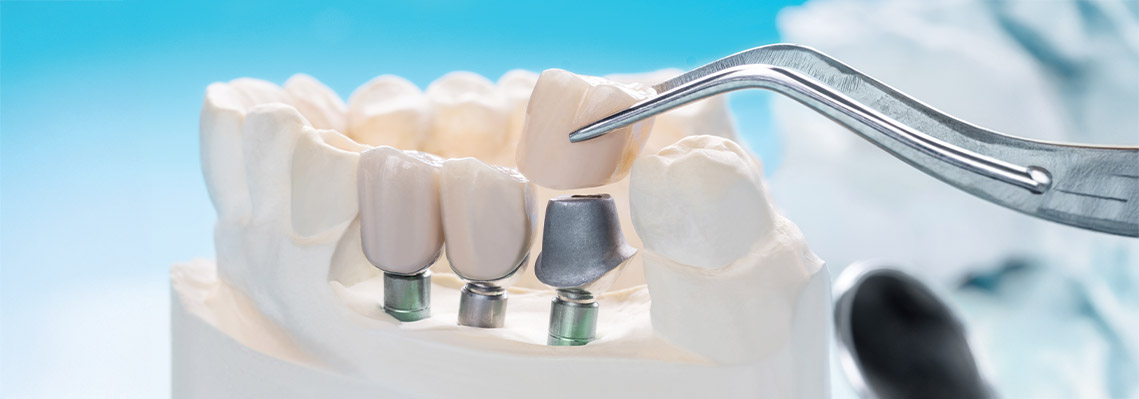Losing a tooth is not just a dental issue; it can also have an effect on your smile, your way of eating, and even how confident you feel around other people. No matter the reason, whether from injury, gum disease, or growing older, losing teeth could change your entire routine. However, thanks to new dental technologies, you can now have that gap taken care of.
If a tooth is missing, the best ways to replace it are with dental implants and dental bridges. Both types have benefits, but how can you choose which one is right for you? Let’s break it down clearly, so you can select an option that fits your needs and lifestyle. if you’re based locally, our team of expert dentist will be glad to walk you through both the options.
Discover the pros and cons of both options to make an informed dental decision today!
A] Understanding the Basics
What Are Dental Implants?
Dental implants generally give you the most natural-looking replacements for missing teeth. They include a titanium post, which works as a tooth’s root and is securely inserted into your jawbone. An artificial abutment was then screwed into the titanium post, and finally a crown that blends over the abutment to match your real teeth.
The reason behind implants appealing to many people is that they are attached to your jawbone, not only to the outer gum tissue. This makes them incredibly stable and long-lasting. There are now clinics that can give you a brand new set or full-arch treatment like an all-on-4 dental implant on the same day.
What Are Dental Bridges?
On the other hand, dental bridges are permanent prosthetics designed to fill the empty spaces created by one or more missing teeth. A bridge works as a false tooth (pontic) that is secured to implant teeth on both sides, called abutments.
There are different types of bridges available, such as:
- Traditional bridges (anchored to crowns on both sides)
- Cantilever bridges (anchored to one side)
- Maryland bridges (using a metal or porcelain framework)
- Implant-supported bridge (strong base of implants to a bridge structure)
Dental bridges in Sunshine Coast utilise quality materials and precise methods to ensure you are comfortable with and have a result that looks natural.
B] Procedure Comparison
Dental Implant Procedure
Dental implant treatment process takes several stages to get completed. First, your doctor will have detailed consultation and planning, including digital imaging to check your bone density and discuss the best tooth replacement option. Next is the surgical placement of the implant post, and then a period of several months passes for the implant to combine with the jawbone through osseointegration. After healing, the abutment and crown are attached, which completes your full smile restoration.
Dental Bridge Procedure
Unlike implants, dental bridges for missing teeth often take less time and can be finished after two visits. Initially, the adjacent teeth are reshaped to fit in the dental crowns. Afterwards, impressions are sent to a lab for the technicians to design and build the bridge. A temporary bridge may be set up for the short term while you wait for your main dental treatment. The moment the permanent bridge arrives, it’s fixed in place for immediate function and aesthetics.
C] Key Factors to Consider When Choosing
Health Considerations
When you are considering dental implants vs bridges, how healthy your mouth is will be very important. You must have a good level of bone and healthy gums before getting dental implants. Individuals with bone loss may have to undergo grafting procedures, which add both extra time and expense to the treatment.
Yet, the health of your adjacent (neighbouring) teeth is necessary for bridges. When the supporting teeth become weak or damaged, the bridge might not last very long. Discussing with your dentist about your gums and jaw will help decide if you are suitable for dental implants.
Lifestyle Factors
Do you want to find a solution that will last a long time, or do you want something that is less invasive and quicker? Dental implants for missing teeth offer a lifelong way that feels completely comfortable and takes little effort to take care of. They’re perfect for people who require items built to last and perform well.
Bridges may work well if your main concern is fast results and a less invasive treatment. Yet, special attention is needed to maintain them, especially to avoid decay around the abutment teeth. Appearance or aesthetics also differ; most people say implants match natural teeth more easily than bridges do. It often needs additional changes for adjustment throughout use.
Financial Aspects
Expenses frequently play a big role in decisions. Dental implants are more expensive to begin with, but they remain strong and last longer, which is why they are seen as a better long-term investment over time. Bridges cost little to build at once, but they may have to be replaced every 5–10 years.
At our clinic, we have flexible payment methods and partner with different insurance companies to help you obtain a dental implant procedure or bridge treatment with more accessibility. You should always weigh upfront expenses against long-term value and potential future procedures.
D] Differences Between Dental Implants and Bridges
The below table highlights that both solutions, dental implants, and bridges, have benefits and drawbacks. Questioning yourself, “Are bridges better than implants?” is not enough; it’s important to consider your own needs as well.
| Feature | Dental Implants | Dental Bridges |
|---|---|---|
| Longevity | 15–25 years or more | 5–15 years |
| Impact on Nearby Teeth | Preserves adjacent teeth | Requires alteration of nearby teeth |
| Time Consumption | Several months (including healing) | 2–3 weeks |
| Aesthetic Results | Highly natural look and feel | Very good, but may need periodic updates |
| Eating & Speaking | Feels like natural teeth | Slight initial adjustment period |
| Lifespan | Longer-lasting | Shorter in comparison |
| Surgical Intervention | Required | Not required (unless implant-supported) |
| Cost | Higher initial cost | Lower initial cost |
| Maintenance | Similar to natural teeth | Requires floss threaders or special care |
E] Long-Term Care and Maintenance
Caring for Dental Implants
Implants need care the same way you look after your natural teeth. An ideal way to keep teeth healthy is to brush them twice daily, floss, and visit a dentist In Sunshine Coast often, to keep them in optimal shape. Getting regular cleanings from your dentist is important to protect your implant against peri-implantitis (inflammation around the implant). These are key long-term benefits of dental implants; they can serve you for decades with proper care.
Caring for Dental Bridges
Bridges need more hygiene efforts than other teeth. Floss threaders or water flossers should be used under the pontic to prevent forming plaque. Also, since the natural teeth supporting the bridge are more at risk, extra care is required to ensure their health and longevity.
Talk to our dental team to find the most suitable solution for you.
Conclusion
Choosing between a dental implant in Sunshine Coast and a bridge is based on your oral health, lifestyle, and budget. In this guide, we have discussed in detail both options. If you are still unclear, our expert dental team is here to guide you on both options and provide a professional opinion on which one is the best for your smile. If you’re looking for tailored advice and treatment, contact us at any time to improve your oral well-being.

Dr. Adarsh Pisharodi
Dr. Adarsh Pisharodi, serving as the principal dentist at Oris Dental, brings a wealth of expertise spanning over 26 years to his esteemed practice. Specializing in cosmetic dentistry, dental implants, and orthodontics, he takes immense pride in rejuvenating countless smiles and instilling confidence in Sunshine Coast residents. As an esteemed member of the Australian Dental Association and esteemed dental societies, he remains steadfast in delivering exceptional care to his patients.















